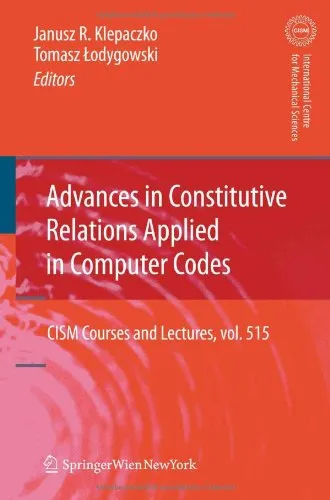Advances in Constitutive Relations Applied in Computer Codes (CISM International Centre for Mechanical Sciences)
3.8
Reviews from our users

You Can Ask your questions from this book's AI after Login
Each download or ask from book AI costs 2 points. To earn more free points, please visit the Points Guide Page and complete some valuable actions.Introduction
Welcome to the world of computational mechanics with Advances in Constitutive Relations Applied in Computer Codes, an essential contribution to the research and application of constitutive modeling in modern engineering processes. Authored by Janusz R. Klepaczko and Tomasz Lodygowski, this volume, part of the CISM International Centre for Mechanical Sciences series, dives deep into the complexities of constitutive relations and demonstrates their practical applicability in computer codes for designing and analyzing materials. This book is profoundly relevant for researchers, engineers, and graduate students seeking to understand the evolving field of computational mechanics and its intersection with material science.
Constitutive relations are foundational mathematical tools that describe how materials respond to external stimuli such as stress, strain, and temperature changes. Their implementation in computer codes bridges the gap between theoretical solid mechanics and real-world engineering applications. This book methodically addresses both fundamental principles and advanced developments, offering readers a comprehensive understanding of constitutive modeling techniques applied in numerical simulations.
Detailed Summary of the Book
The book unfolds as a rich exploration of constitutive modeling, organized into well-structured chapters that highlight advancements in the field. The authors meticulously examine nonlinear material behavior, damage mechanics, plasticity, viscoplasticity, and thermodynamic principles, making this work a definitive reference for complex mechanical problems.
Starting with the historical context, the book introduces classical formulations, steadily proceeding towards modern approaches. Topics covered include elastoplastic behavior under cyclic loading, rate-dependent responses, and modeling under extreme physical environments. The integration of constitutive relations into finite element analysis (FEA) is extensively discussed, shedding light on how computational tools can replicate the intricate behavior of real-world materials.
Each chapter combines theoretical explanations, mathematical formulations, and illustrative examples, offering clear guidance to the reader. By detailing algorithms and their implementation, the book ensures that both academicians and practitioners can effectively utilize computer codes for predictive analysis and design optimization.
Key Takeaways
- A thorough understanding of constitutive relations, including elastoplastic and viscoplastic models.
- Insights into computational mechanics and the integration of constitutive equations in FEA software.
- Exploration of damage mechanics and material failure prediction techniques.
- Advanced modeling approaches for materials subjected to complex loading and environmental conditions.
- Real-life applications and case studies demonstrating theoretical concepts in action.
Famous Quotes from the Book
"Constitutive relations are not mere mathematical expressions—they are the language materials use to articulate their behavior under external forces." — Janusz R. Klepaczko
"The interplay between theoretical predictions and experimental validation is the cornerstone of engineering; this book aims to strengthen that bond with computational tools." — Tomasz Lodygowski
Why This Book Matters
In an era dominated by technological advancement, the ability to predict and control material behavior is more critical than ever. Advances in Constitutive Relations Applied in Computer Codes strikes a perfect balance between theoretical exploration and practical relevance, filling a gap in the educational and research ecosystem. Constitutive modeling profoundly influences sectors ranging from aerospace engineering to biomechanics, and this book serves as a valuable resource for professionals aiming to push the boundaries of their domain.
Furthermore, the text is not confined to academia—it offers actionable insights for engineers engaged in industrial projects, enabling them to model, simulate, and optimize the performance of materials with unparalleled precision. This book stands as a testament to the authors' rigor, vision, and dedication to advancing the nexus of computational mechanics and material science.
Whether you're a seasoned professional or a student entering the field, this book will empower you to tackle complex challenges with confidence and deepen your understanding of the crucial role constitutive relations play in engineering applications. It truly is a must-read for anyone vested in the future of computational and mechanical sciences.
Free Direct Download
You Can Download this book after Login
Accessing books through legal platforms and public libraries not only supports the rights of authors and publishers but also contributes to the sustainability of reading culture. Before downloading, please take a moment to consider these options.
Find this book on other platforms:
WorldCat helps you find books in libraries worldwide.
See ratings, reviews, and discussions on Goodreads.
Find and buy rare or used books on AbeBooks.


